Richard Strauss was born in Munich 150 years ago today. Christian Thielemann is celebrating the fact by conducting the Staatskapelle Dresden in the juiciest of all-Strauss operatic potpourris, a festive concert to be held in the city’s glorious Semperoper. What wouldn’t I give to hear Anja Harteros, alongside Anne Schwanewilms the loveliest of Strauss sopranos, and chaste nymph Daphne’s metamorphosis into a laurel in a peerless operatic epilogue? In fact the Dresden Music Festival, my host, ended yesterday and seems to function as a separate entity with its own period-instrument orchestra. I can't be too sad not to have stayed on as I must catch Poulenc’s Carmelites before they mount the scaffold for the last time at Covent Garden. But I’ve had my Strauss vision in Dresden, as well as the first great Berlin Philharmonic concert I’ve heard in that orchestra’s home, and I wouldn’t have missed either for the world.
The Dresden festival’s big project this year was to present three semi-staged performances of Feuersnot (Fire-famine), Strauss’s second opera and a slightly warped comedy of Munich philistinism versus creativity in the shape of a magician – symbolizing Wagner, drummed out of town – and his heir apparent, Kunrad – Strauss himself, it's implied, who in 1900 was still smarting at the failure of his first work for the stage, the arch-Wagnerian Guntram, in that conservative city. The even more scabrous source has the girl who crosses the hero forced to stand naked in public so that the Beltane fire supernaturally snuffed out can be lit from her backside. Strauss and his satirist librettist Ernst von Wolzogen go easier on heroine Diemut: a bit of longed-for rumpy-pumpy is enough to turn on the lights, and it gives Strauss the opportunity for another sex scene after the pleasures of Don Juan and Ein Heldenleben.
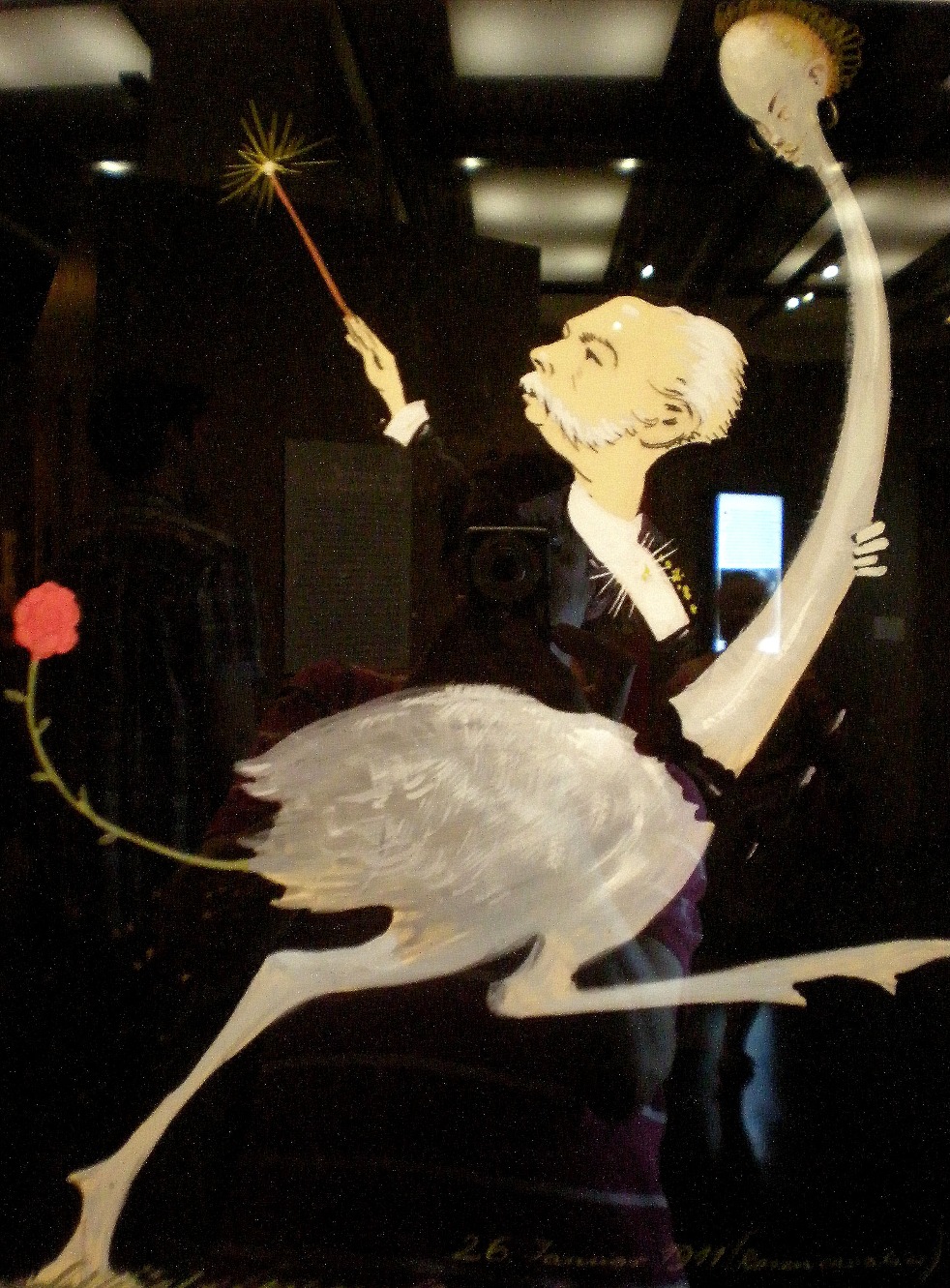 Feuersnot’s climactic finale is all we usually hear of this lively gem – and even then only on recordings, rarely in the concert hall. Dresden's resuscitation, standing alone with a full anniversary production earlier this year in Palermo of all places, came 113 years on from the opera's world premiere there under the baton of Ernst von Schuch. There’s a fine little exhibition in the city's Stadtmuseum to mark the 100th anniversary of Schuch’s death in 1914. By that time, as a Generalmusikdirektor so famous that the Saxon State Railway changed the timetable to allow him to get from his beloved residence, the Villa Favorita in Lößnitz, to rehearsals and performance in good time, he’d conducted 41 premieres over 40 years at the Semperoper, including those of Salome, Elektra and Der Rosenkavalier (Schuch pictured above in a 1911 caricature with a pun on Strauss's name, meaning "ostrich"; apologies, no better reproduction available).
Feuersnot’s climactic finale is all we usually hear of this lively gem – and even then only on recordings, rarely in the concert hall. Dresden's resuscitation, standing alone with a full anniversary production earlier this year in Palermo of all places, came 113 years on from the opera's world premiere there under the baton of Ernst von Schuch. There’s a fine little exhibition in the city's Stadtmuseum to mark the 100th anniversary of Schuch’s death in 1914. By that time, as a Generalmusikdirektor so famous that the Saxon State Railway changed the timetable to allow him to get from his beloved residence, the Villa Favorita in Lößnitz, to rehearsals and performance in good time, he’d conducted 41 premieres over 40 years at the Semperoper, including those of Salome, Elektra and Der Rosenkavalier (Schuch pictured above in a 1911 caricature with a pun on Strauss's name, meaning "ostrich"; apologies, no better reproduction available).
It was clear to an exhilarated audience at the end of the Saturday premiere that Feuersnot is worthy to stand alongside those much better-known masterpieces. The entire one-and-a-half-hour entertainment is a beautifully structured piece of work dating from Strauss’s artistic high noon, moving suavely from lively children’s choruses and Bavarian waltzes through to the central nocturne and a blazing denouement.
The original setting is Munich on Midsummer Eve, “in legendary non-time”. The open-air courtyard of Dresden’s Royal Palace or Residenzschloss, home to a couple of the world’s great museums, was the approximately authentic scene, a breathtaking one opened to the Festival audience for the first time since its destruction in the Second World War (the general public will have to wait a few more months while the final restorations are completed). Here’s one place in Dresden where the wildly extravagant influence of Augustus the Strong in the early 18th century isn’t paramount; the Renaissance work of 1530 is due to Duke George the Bearded’s taking up residence.
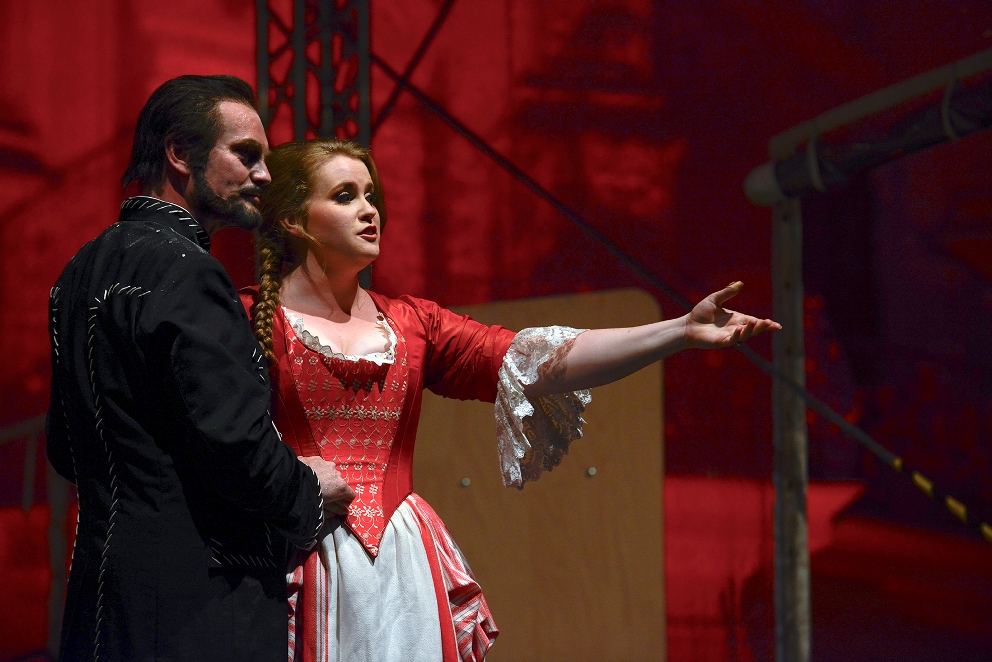 My seat was way too close to the large stage to judge the achievement of the Dresden Festival Orchestra under the reasonably agile control of Stefan Klingele (today conducting Die Liebe der Danae, the best of all the neglected Strauss operas, in the composer’s home base of Garmisch-Partenkirchen with Anne Schwanewilms as the heroine). You’d have had to be at least half way back to hear the blend, as well as take in the full splendour of the courtyard setting. When I could hear the voices properly – and most of the limited action took place on the opposite side of the platform to where I was sitting – it became obvious that we had one true star in the cast, Rachel Willis-Sørensen (pictured above with Tómas Tómasson's Kunrad) as the teasing, insecure heroine. Fast vibrato to start with was soon offset by luminous warmth, a very beautiful middle register and an ability to carry the voice up to the warmest of top notes which marks her out as a true Straussian soprano.
My seat was way too close to the large stage to judge the achievement of the Dresden Festival Orchestra under the reasonably agile control of Stefan Klingele (today conducting Die Liebe der Danae, the best of all the neglected Strauss operas, in the composer’s home base of Garmisch-Partenkirchen with Anne Schwanewilms as the heroine). You’d have had to be at least half way back to hear the blend, as well as take in the full splendour of the courtyard setting. When I could hear the voices properly – and most of the limited action took place on the opposite side of the platform to where I was sitting – it became obvious that we had one true star in the cast, Rachel Willis-Sørensen (pictured above with Tómas Tómasson's Kunrad) as the teasing, insecure heroine. Fast vibrato to start with was soon offset by luminous warmth, a very beautiful middle register and an ability to carry the voice up to the warmest of top notes which marks her out as a true Straussian soprano.
Unfortunately, for the second and only time in Strauss’s operas, the soprano plays second fiddle to a male protagonist. Kunrad, like Guntram, is a hell of a sing, even with a few small cuts in the big climactic monologue, and as with the role of Jupiter in Die Liebe der Danae the ideal exponent would be a bass-baritone with a ringing upper register. Tómasson began as a bass, and still can’t afford to be relaxed in highest exultation. Impressively Mephistophelian in appearance, he’s no great shakes as an actor - "park and bark" sums up the style - and so the big scene with its satirical references to Wagner, Strauss and Wolzogen fell a bit flat.
The women generally projected and characterised better than the men, especially Carolina Ullrich leading a trio which looks forward to the nymphs in Ariadne auf Naxos, while Ticina Vaughn and Catalina Bertucci shone among the philistine Müncheners. The crucial children’s choruses – can their difficulty be a reason for present neglect? – shone in the hands of the Dresden Singakadamie Kinderchor, and a true operatic chorus, from the State Opera, no less, added heft to the last big ensemble. Ultimately, the work won out. Should it be staged here? Absolutely, and ideally in a witty new English translation to get round the Munich dialect problem at ENO staged by Richard Jones, who ought to respond well to some of the surreal comic elements.
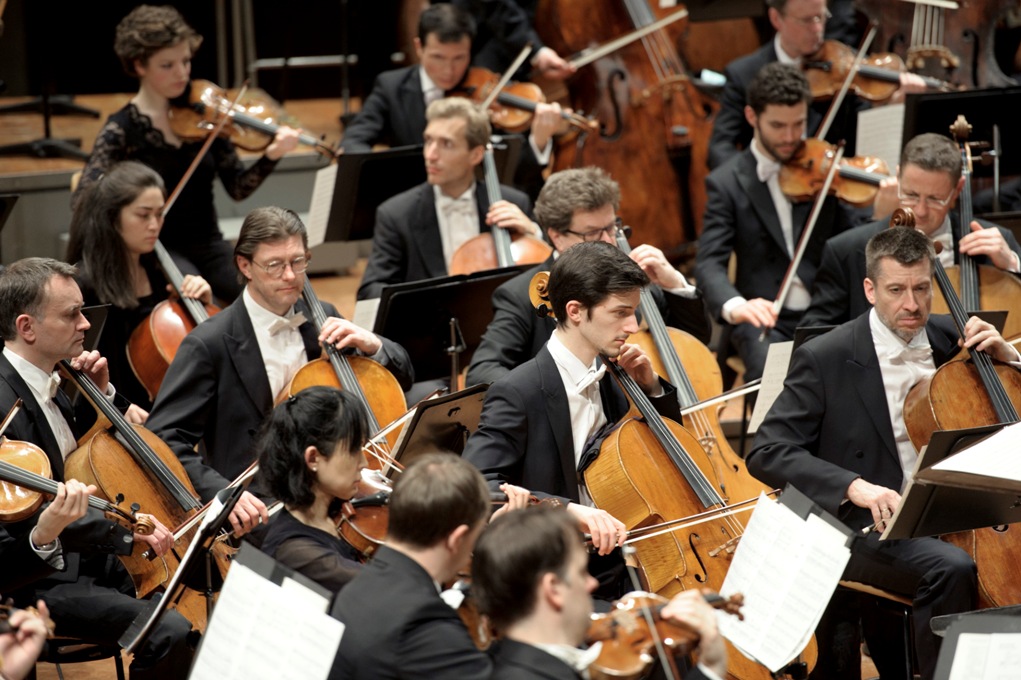 All good things on this trip came in threes. My Dresden stay was bracketed by two other Strauss-dominated events, a Leipzig Gewandhausorchester spectacular in the Semperoper at the end and a concert in Berlin before I took the coach south in which the poor impression left by my two previous experiences of the world’s most luxurious orchestra, the Philharmoniker, in its fabulous Scharoun-designed home was redeemed by Semyon Bychkov outstripping principal conductor Simon Rattle and replacing an indisposed Lorin Maazel. The original all-Strauss programme I’d intended to avoid for two reasons. The first was the evidence of Maazel’s testudinal recent Mahler with our Philharmonia, the second his choice of the Rosenkavalier Suite: the Presentation of the Rose minus two and the Trio minus three in terms of voices simply wouldn’t do after recent operatic treats in London, Birmingham and Glyndebourne.
All good things on this trip came in threes. My Dresden stay was bracketed by two other Strauss-dominated events, a Leipzig Gewandhausorchester spectacular in the Semperoper at the end and a concert in Berlin before I took the coach south in which the poor impression left by my two previous experiences of the world’s most luxurious orchestra, the Philharmoniker, in its fabulous Scharoun-designed home was redeemed by Semyon Bychkov outstripping principal conductor Simon Rattle and replacing an indisposed Lorin Maazel. The original all-Strauss programme I’d intended to avoid for two reasons. The first was the evidence of Maazel’s testudinal recent Mahler with our Philharmonia, the second his choice of the Rosenkavalier Suite: the Presentation of the Rose minus two and the Trio minus three in terms of voices simply wouldn’t do after recent operatic treats in London, Birmingham and Glyndebourne.
Enter Bychkov and a change of programme: the most elaborate and fascinating of all Strauss’s symphonic poems, Don Quixote - variations, concerto and a superb distillation of Cervantes’s masterpiece rolled into one - in the first half, Schubert’s Great C major Symphony (confusingly now known as the Eighth, which we think is the “Unfinished”, rather than the Ninth) in the second. It’s probably the first time in concert where I’ve heard the role of the melancholy knight taken by an orchestral principal rather than a starry cellist, though star Bruno Delepelaire (in the centre of the cellists at a previous concert above, by Monika Rittershaus) absolutely was. Not only did he have the elongated look of a young Quixote to Hungarian viola-player Máté Szücs' more rotund Sancho Panza; he dominated the great solos of the knight’s vigil for Dulcinea and his deathbed scene with incredible subtlety and range of tone.
Bychkov’s natural element is earth rather than air, much like the phantasmagorically orchestrated flight on the wooden horse where a blindfolded knight and squire only imagine themselves airborne, but he never dropped a stitch in this most complex of scores. The contrapuntal madness with which Strauss anticipated Schoenberg’s First Chamber Symphony of 1906 by nearly a decade, the brass-bleating atonal sheep, trombone slurs, pizzicato-dripping voyage downstream in an “enchanted” boat, the tragic homecoming with its doom-beating timpani: all these were incomparably well done.
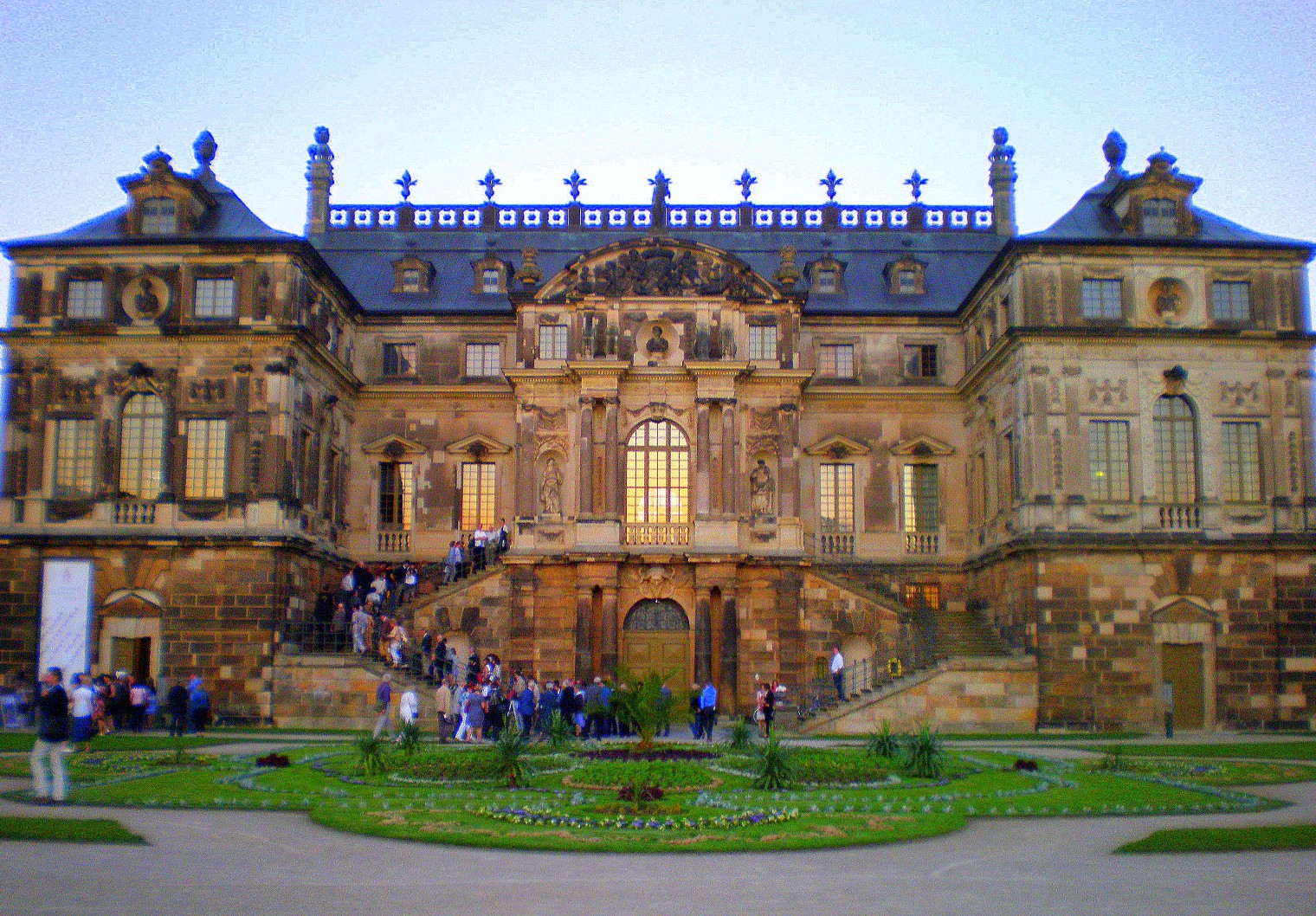 Bychkov also proved what a master he is of flexible dance music in the Scherzo of the Schubert symphony. All repeats were here except the one in the finale, and as the music seemed so easily loved by players and conductor it was a case of heavenly length indeed, as Schumann put it, the music's mostly genial glory crowned by my favourite orchestral oboist, Albrecht Mayer (though what an explosion here at the heart of the nocturnal second movement).
Bychkov also proved what a master he is of flexible dance music in the Scherzo of the Schubert symphony. All repeats were here except the one in the finale, and as the music seemed so easily loved by players and conductor it was a case of heavenly length indeed, as Schumann put it, the music's mostly genial glory crowned by my favourite orchestral oboist, Albrecht Mayer (though what an explosion here at the heart of the nocturnal second movement).
Schubert came in threes, too: the next evening I found myself listening to two more late masterpieces, the F minor Fantasie for four-hand piano and the String Quintet, in the building I think I now love best in all Dresden, the Palais im Großen Garten. Outside, it’s a perfect baroque 1680 summer palace (pictured above in the interval) its colour naturally blackened in part as Dresden's stones ought to be, in the middle of wonderful public grounds, Dresden’s answer to Central or Hyde Parks. But once you’ve ascended one side or other of the grand symmetrical staircase and entered the big ballroom, you find yourself dwarfed by exposed brickwork, crumbling pilasters and headless statues, with only a couple of columns restored to show what might be done – and I hope is not, for Dresden has already succumbed to recreative mania, and needs to preserve a different atmosphere. I promised I'd support the battle to keep the Palais as it is (interior pictured below).
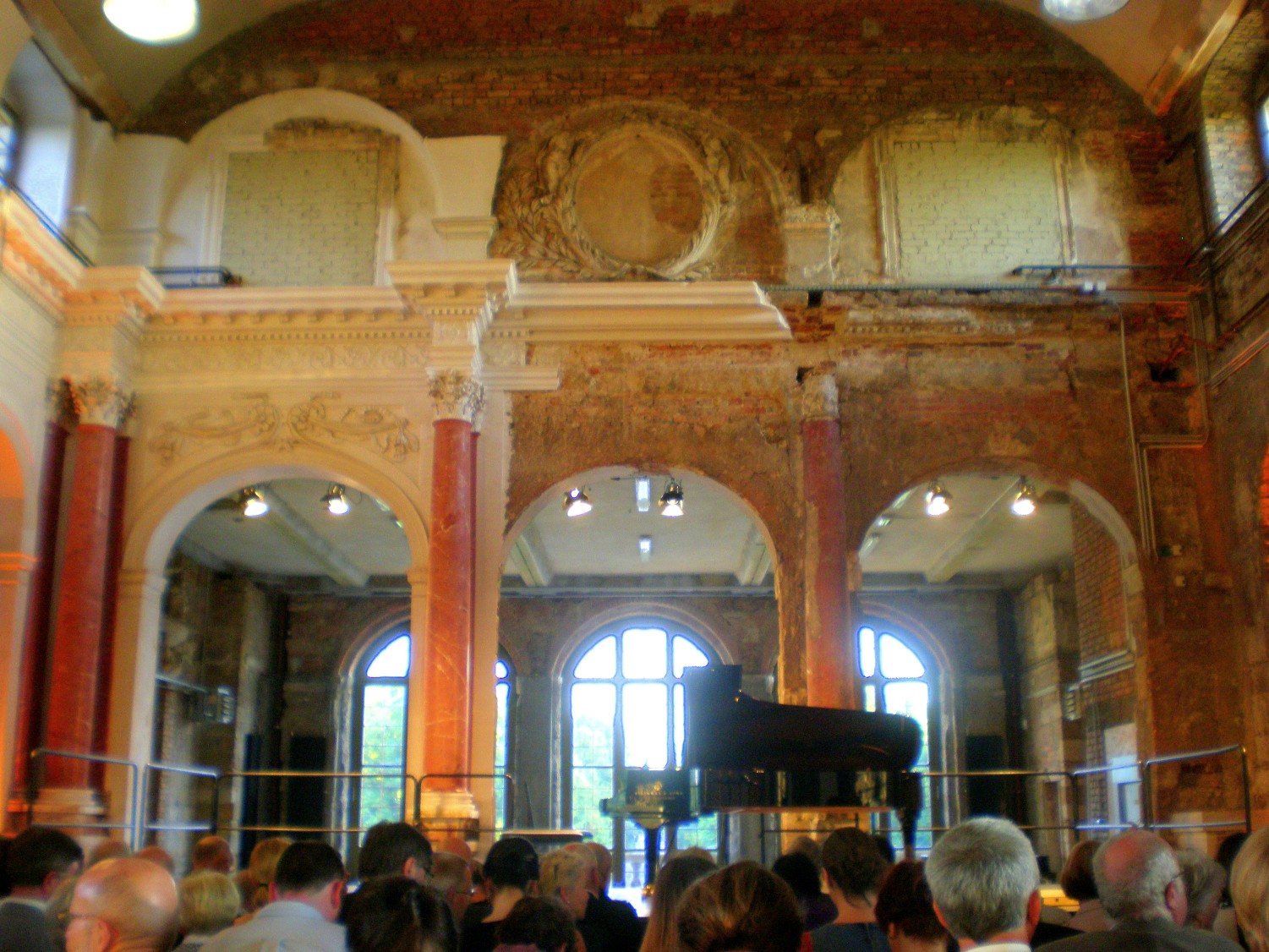 Would, moreover, the acoustics be quite as superb if the restoration were to take place as they are now in the semi-ruin, which works so well with the fragile pathos of Schubert’s late style? Neither performance from the Chamber Music Society of Lincoln Center was absolutely top-notch. There’s more between the lines of the unstable Fantasie than was quite in the philosophy of Gloria Chien and Wu Han, though I wonder if the situation might have been different if the supremely characterful Han had been on top. Likewise with the violinists Kristin and Yura Lee: Kristin seemed stronger in the 15 year old Mendelssohn’s Sextet than Yura was in the Quintet. The difference in sound between the pleasingly plump cello tone of festival director Jan Vogler, joining the Lincolners for the Quintet, and the more slimline David Finckel worked well, though. And Han was the undisputed virtuoso leader of the quirky early Mendelssohn piece, letting its Mozartian aspects speak for themselves but vivaciously underpinning the first movement’s pounding coda and the vitality of the scherzo, its best asset, which returns so unexpectedly to almost, but not quite, end the D major piece in the minor. This was the effervesecent highlight, performance-wise.
Would, moreover, the acoustics be quite as superb if the restoration were to take place as they are now in the semi-ruin, which works so well with the fragile pathos of Schubert’s late style? Neither performance from the Chamber Music Society of Lincoln Center was absolutely top-notch. There’s more between the lines of the unstable Fantasie than was quite in the philosophy of Gloria Chien and Wu Han, though I wonder if the situation might have been different if the supremely characterful Han had been on top. Likewise with the violinists Kristin and Yura Lee: Kristin seemed stronger in the 15 year old Mendelssohn’s Sextet than Yura was in the Quintet. The difference in sound between the pleasingly plump cello tone of festival director Jan Vogler, joining the Lincolners for the Quintet, and the more slimline David Finckel worked well, though. And Han was the undisputed virtuoso leader of the quirky early Mendelssohn piece, letting its Mozartian aspects speak for themselves but vivaciously underpinning the first movement’s pounding coda and the vitality of the scherzo, its best asset, which returns so unexpectedly to almost, but not quite, end the D major piece in the minor. This was the effervesecent highlight, performance-wise.
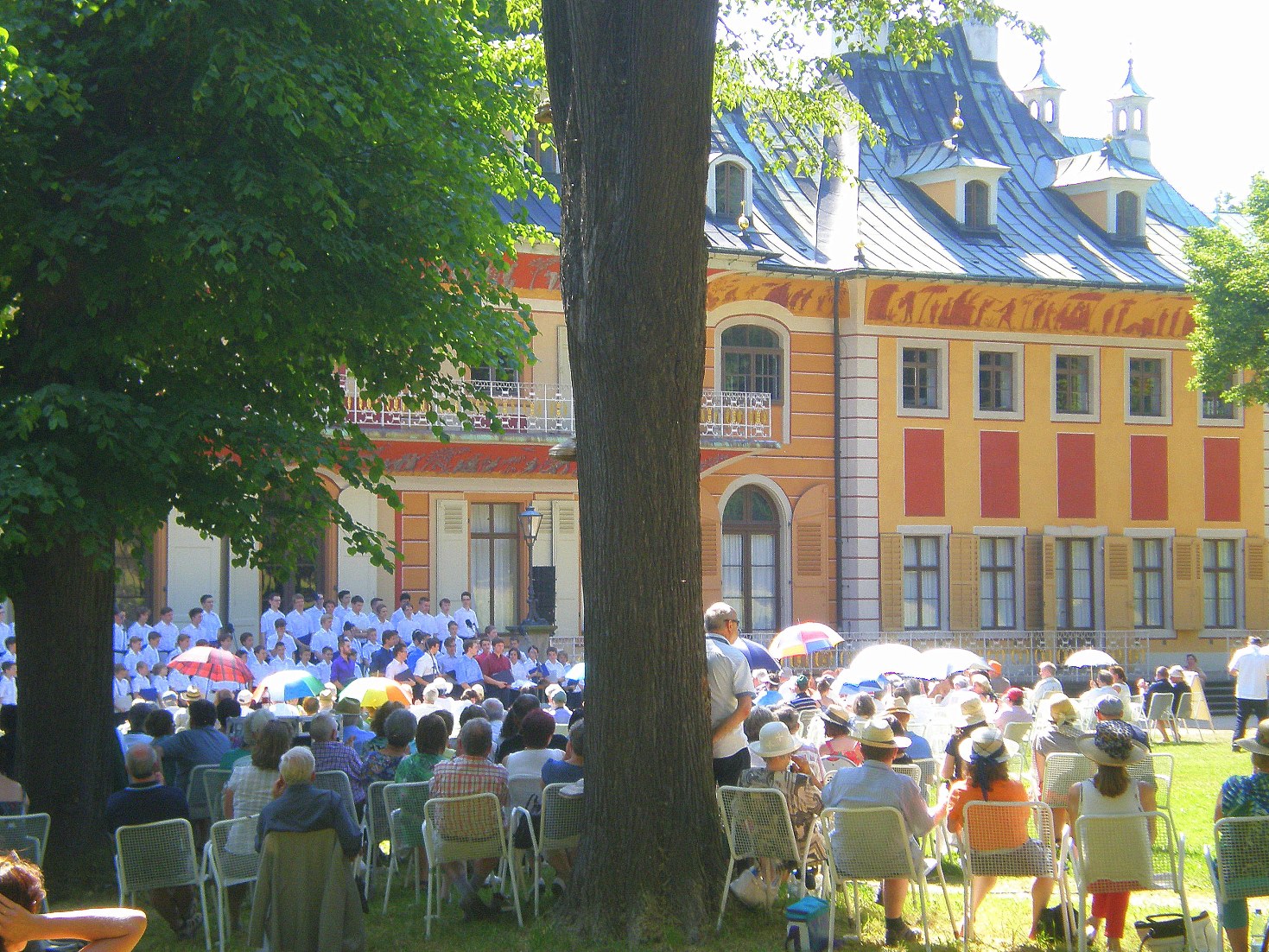 Dresden has an infinity of characterful venues, many of which surely remain to be tapped. But an excursion along the beautiful Elbe to the pleasure palace of Pillnitz was the best possible thing to do in a heatwave which had Dresdeners standing waist-deep in the waters to cool off. Here the nearly 800 year old Kreuzchor of boys and young men, released from their morning Pentecostal duties in the famously reconstructed Frauenkirche, sang of nightingales and spring while the audience, having removed nearly all the seats from the open space between avenues of limes and chestnuts, experienced the real sounds of nature in a delicious haze under the trees (pictured above).
Dresden has an infinity of characterful venues, many of which surely remain to be tapped. But an excursion along the beautiful Elbe to the pleasure palace of Pillnitz was the best possible thing to do in a heatwave which had Dresdeners standing waist-deep in the waters to cool off. Here the nearly 800 year old Kreuzchor of boys and young men, released from their morning Pentecostal duties in the famously reconstructed Frauenkirche, sang of nightingales and spring while the audience, having removed nearly all the seats from the open space between avenues of limes and chestnuts, experienced the real sounds of nature in a delicious haze under the trees (pictured above).
I also had no trouble rejecting a not too promising looking Beethoven Missa Solemnis in the Semperoper in favour of Cameron Carpenter’s travelling-organ spectacular in the Altes Schlachterhof. This was not, as I'd hoped, the infamous Slaughterhouse Five of Kurt Vonnegut’s astounding semi-autobiographical novel - how the city has changed since Vonnegut returned in 1967 and found "it looked a lot like Dayton, Ohio, more open spaces than Dayton has" - but not far from that still-extant site, and atmospherically converted for rock stars.
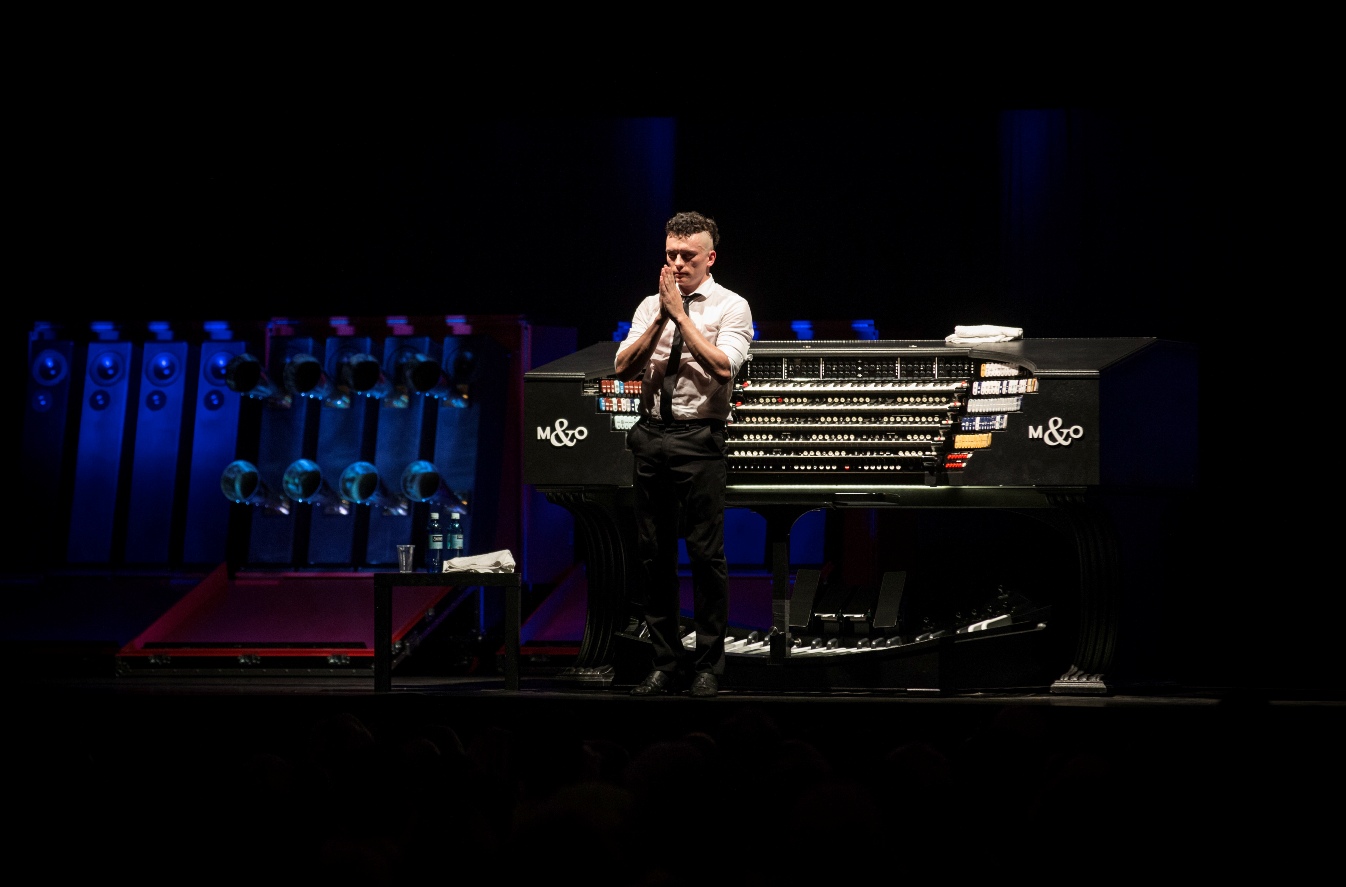 Carpenter (pictured right by Oliver Killig) is already among their number, to judge from the wild enthusiasm of the packed and sweat-dripping audience. Nobody else seemed to find it as funny as I did when Carpenter pulled out a few too many stops to wurlitz, burp and fart his way through Mozart and Dupré variations (though he calmed down for Bach-lite, a substitution prompted by his bad temper in the heat). The visual spectacle of Carpenter’s keyboard surrounded by his ten blue-lit crates of pipes would have been worth the price of admission alone.
Carpenter (pictured right by Oliver Killig) is already among their number, to judge from the wild enthusiasm of the packed and sweat-dripping audience. Nobody else seemed to find it as funny as I did when Carpenter pulled out a few too many stops to wurlitz, burp and fart his way through Mozart and Dupré variations (though he calmed down for Bach-lite, a substitution prompted by his bad temper in the heat). The visual spectacle of Carpenter’s keyboard surrounded by his ten blue-lit crates of pipes would have been worth the price of admission alone.
Thielemann and the Staatskapelle, albeit with vocal stars, cannot hope for greater success in the Semperoper tonight than Chailly and the Leipzig Gewandhaus Orchestra had on a holiday Monday morning. The revelation for me was a work I’ve never heard live in concert before, Brahms’s Second Serenade, perfect summer music for a curious ensemble lacking violins and focusing on the woodwind: more superlative oboe work here. Less so from the D clarinet and horn in Strauss’s Till Eulenspiegel, but as part of a second-half double bill prefaced by Tod und Verklärung (Death and Transfiguration) it took off with razor-sharp articulation and the same immaculate balances as the darker, more pretentious symphonic poem had before it. Chailly (pictured below to the right with Leipzig players in the Semperoper by Sinan Cakmak) thinks of everything in terms of orchestral layout and the right sound; he certainly puts his Leipzig orchestra up there with the Berliners and the Dresdeners. If I were Vogler, though, I’d have asked the visitors to play Strauss’s "memorial waltz" München as an official encore: its main theme, bearing a striking resemblance to “My Bonnie Lies Over the Ocean”, comes straight out of Feuersnot's hymn to a great but frustrating city.
 That missed opportunity to gild the lily apart, the festivities were rich indeed. I’ve never been with a funnier, more subversive or cleverer bunch of international journalists; it was good to chew the cud on the situations in Moscow, Istanbul and Beijing, and to sit with good company over an intoxicating lunch at the superb Schloss Wackerbarth vineyards - the award-winning Gewürztraminer warmly recommended - or in a riverside beer garden into the small hours of a perfect summer night.
That missed opportunity to gild the lily apart, the festivities were rich indeed. I’ve never been with a funnier, more subversive or cleverer bunch of international journalists; it was good to chew the cud on the situations in Moscow, Istanbul and Beijing, and to sit with good company over an intoxicating lunch at the superb Schloss Wackerbarth vineyards - the award-winning Gewürztraminer warmly recommended - or in a riverside beer garden into the small hours of a perfect summer night.
Dresden, in short, is the ideal summer city, if it’s a city you must be in at this time of year. I was here last June on my birthday to see Der Rosenkavalier in the house where it was born: the recent floods had stopped the scenery from arriving, but as Anne Schwanewilms was the Marschallin, Elina Garança the Octavian and Thielemann conducted, you can imagine it did not disappoint.
On that visit I gaped at the lunatic trinkets of August the Strong’s treasurehouse, the Green Vaults, revisited possibly the world’s greatest picture collection in the Gemäldegalerie, and saw how the Frauenkirche had risen again from the few walls that were standing when I first came (for Rosenkavalier recording sessions with Haitink in the Lukaskirche) in 1990. This time there were all too few hours between the official programme to fill in the gaps, but I did whizz round a reasonably interesting exhibition celebrating Dionysus in statues and paintings (the antiquities, including a stunning Etruscan bronze and a Pompeiian fresco of the abandoned Ariadne, were better than the more recent paintings). l’ll be back next year hoping for the same sunshine on the Elbe, Strauss or no Strauss.
- David Nice's blog account of last year's Dresden Rosenkavalier
- A BBC Radio 3 podcast introduction to Feuersnot with contributions from William Mival, David Nice and Hugo Shirley














Add comment